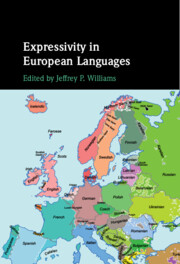Book contents
- Expressivity in European Languages
- Expressivity in European Languages
- Copyright page
- Contents
- Figures
- Tables
- Contributors
- 1 Introduction
- Uralic
- 2 Hypocoristic reduplications and embellished clippings in Hungarian and elsewhere
- 3 Reduplication in Finno-Ugric languages
- Germanic
- Hellenic
- Romance
- Celtic
- Vasconian
- Caucasian
- Comparative
- Index
- References
3 - Reduplication in Finno-Ugric languages
from Uralic
Published online by Cambridge University Press: 24 August 2023
- Expressivity in European Languages
- Expressivity in European Languages
- Copyright page
- Contents
- Figures
- Tables
- Contributors
- 1 Introduction
- Uralic
- 2 Hypocoristic reduplications and embellished clippings in Hungarian and elsewhere
- 3 Reduplication in Finno-Ugric languages
- Germanic
- Hellenic
- Romance
- Celtic
- Vasconian
- Caucasian
- Comparative
- Index
- References
Summary
The chapter provides a general overview of lexical reduplication in Finno-Ugric languages. The research data are taken from observations of everyday life and from various written sources for major languages of this family: Finnic (Finnish, Estonian), Saamic, Mordvinic (Erzya, Moksha), Mari, Permic (Komi, Udmurt), Ugric (Hungarian, Mansi, Khanty). Finno-Ugric reduplication is rich, because, on one hand, agglutinative properties of these languages favor mergeability and repetition of various stems; on the other hand, many onomatopoeias and descriptive words (ideophones) can function as various parts of speech, mainly as adverbs and adjectives, which are often repeated. They also sometimes complete nouns or verbs. Repetitive constructions can express various semantic shades, mainly intensification, iterativity, distributivity, multiplicity, frequency, or indefiniteness. Finno-Ugric reduplication is total or partial (which is more frequent). Reduplicative tendencies are more visible and productive in Hungarian, Komi, Udmurt, and Mari, than in Saamic, in which they barely exist.
Keywords
- Type
- Chapter
- Information
- Expressivity in European Languages , pp. 53 - 88Publisher: Cambridge University PressPrint publication year: 2023



